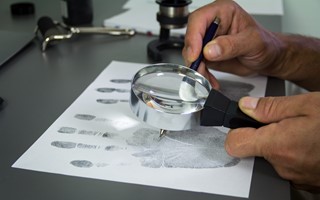News February 24, 2025
Firearm-related forensic evidence plays a pivotal role in criminal investigations and legal proceedings. From identifying weapons to determining ballistic matches, forensic firearm examiners provide crucial insights that contribute to case resolution and justice.
This article draws from a recent Forensic Access webinar, “Aiming for Precision in Forensic Science”, which explored the complexities of firearm examinations and classification in the UK legal system. The session provided an in-depth look at the types of firearms and ammunition commonly encountered in forensic investigations, the legal classifications that determine whether a weapon is prohibited, and the forensic techniques used to analyse firearms-related evidence.
With a growing number of cases involving modified weapons, imitation firearms, and even 3D-printed gun components, forensic expertise in this area is more critical than ever.
The Role of Firearm Examination in Criminal Cases
Forensic firearm examination is a highly specialised discipline that involves analysing weapons, ammunition, and related evidence to determine their role in criminal activity. The work of forensic firearm experts spans a variety of cases, from serious offences including murder and manslaughter to armed robberies, illegal possession, and firearms trafficking.
Key aspects of firearm examinations can include:
- Identifying and classifying firearms, including modified, imitation, and antique weapons.
- Assessing whether a weapon meets the legal definition of a firearm under UK legislation.
- Determining whether a firearm has been discharged and linking it to ballistic evidence.
- Examining cartridge cases and bullets to identify unique tool marks that indicate the specific weapon used.
- Evaluating 3D-printed components and their functionality.
Forensic Access experts have examined thousands of cases involving firearm-related evidence, supporting criminal investigations and providing expert testimony in court.
Understanding Firearm types and their functions
One of the most important aspects of firearm examination is understanding the different types of weapons and how they function. Although all firearms share the same basic purpose—firing a projectile toward a target—there are numerous designs and mechanisms that influence how they operate.
Some of the key firearm types encountered in forensic investigations can include:
1. Handguns
- Semi-automatic pistols: Fire one round per trigger pull and reload automatically from a magazine.
- Revolvers: Use a rotating cylinder to hold ammunition; each chamber aligns with the barrel when fired.
2. Rifles
- Bolt-action rifles: Require manual operation of the bolt to chamber the next round.
- Lever-action rifles: Use a lever mechanism to chamber rounds.
- Semi-automatic rifles: Fire one round per trigger pull and reload using gas or recoil-operated cycling mechanisms.
3. Shotguns
- Pump-action shotguns: Require manual operation of the fore-end to load a new shell.
- Semi-automatic shotguns: Use gas or recoil-operated mechanisms to reload automatically.
- Sawn-off shotguns: Modified to have a shorter barrel for concealability, often making them prohibited under UK law.
Understanding these firearm types helps forensic experts determine how a weapon was used in a crime, whether it has been modified, and whether it meets legal classification as a prohibited firearm.
The Legal Classification of Firearms in the UK
Firearm legislation in the UK is among the strictest in the world. Firearms examiners provide critical expertise in determining whether a weapon is legal, restricted, or prohibited under UK law.
Key legal considerations include:
- Lethality: A ‘firearm’ must discharge a projectile with a muzzle energy above one joule to be legally classified as a "lethal barrelled weapon."
- Classification: Firearms fall into categories such as shotguns, air weapons, antique firearms, and prohibited weapons.
- Modification: Alterations, such as sawing off a shotgun barrel or converting a blank-firing weapon to fire live rounds, can change a weapon’s legal status.
- Imitation Firearms: Some replicas, including blank-firing guns and airsoft weapons, can be mistaken for real firearms, making classification crucial in legal cases.
- Ammunition Restrictions: Certain types of ammunition, such as armour-piercing or incendiary rounds, are prohibited.
Expert forensic classification ensures that courts receive accurate assessments of firearm status, helping to guide appropriate legal outcomes.
The role of Air Weapons and their classification
Air weapons, commonly used for sport and pest control, have strict classification guidelines. Forensic analysis helps determine their legality based on:
- Muzzle energy: Air pistols exceeding 6 foot-pounds and air rifles over 12 foot-pounds require certification.
- Modifications: Some air weapons are unlawfully altered to increase power, making them classified as firearms.
- Test firing: Chronograph testing measures velocity to assess compliance with UK law.
The importance of Ammunition Examination
Ammunition is crucial in forensic investigations, with experts analysing:
- Calibre and manufacturer to match bullets to weapons.
- Live or inert status to determine whether seized ammunition is viable.
- Prohibited ammunition types, such as armour-piercing or incendiary rounds.
The Concept of ‘Readily Convertible’ Firearms
Some blank-firing or deactivated weapons can be modified to fire live ammunition. Forensic experts assess:
- Ease of modification
- Required tools
- Previous alterations
These assessments are increasingly relevant with the rise of 3D-printed gun components.
Case Studies: The Importance of Firearm Examination
Anonymised case studies from the webinar highlighted how forensic firearm examination supports fair legal outcomes by challenging assumptions and ensuring evidence is interpreted accurately.
1. Modified Firearm Assessment
In one case, a shotgun had been seized during a police operation. Initially, it was classified as a standard shotgun requiring a certificate. However, upon forensic examination, it was found to have been sawn-off, reducing its barrel length to below 24 inches, making it a prohibited weapon under UK law. This reclassification had significant implications for the charges brought against the suspect.
2. Cartridge Case Examination and Ballistics Matching
A shooting incident left several fired cartridge cases at the scene. Forensic experts conducted microscopic comparisons of the recovered casings with test-fired samples from a suspect’s firearm. The analysis identified distinctive firing pin and extractor marks, confirming that the casings had been fired from that specific weapon. This evidence was pivotal in securing a conviction.
3. Imitation Firearms and Legal Classification
A suspect was arrested in possession of what appeared to be a real handgun. However, forensic examination revealed it was an imitation firearm incapable of firing live ammunition. The findings were crucial in determining the appropriate charges, preventing an unnecessary firearms offence conviction.
These cases illustrate the critical role forensic firearm examiners play in ensuring that firearms-related evidence is accurately assessed and legally classified.
Advancements in Firearm Examination: 3D-Printed Firearms
The emergence of 3D-printed firearms presents new challenges for law enforcement and forensic investigators. While 3D printing has been used to manufacture firearm components for years, recent advancements have made it possible to create fully functional firearms with minimal machining.
Key issues related to 3D-printed firearms include:
- Ease of Manufacturing: Files for printing gun components are easily accessible online.
- Legal Implications: Simply possessing 3D-printed firearm components, or the digital files used to create them, may constitute an offence.
- Forensic Challenges: Identifying and tracing 3D-printed weapons requires specialised forensic techniques, as they may lack traditional tool marks found on factory-manufactured firearms.
Forensic Access experts are at the forefront of addressing these emerging threats, ensuring that forensic methods evolve alongside technological advancements.
Conclusion: The Essential Role of Firearm Examiners
Forensic firearm examination is a specialised and evolving field that plays a crucial role in the criminal justice system. From identifying and classifying weapons to matching ballistic evidence, forensic experts provide the courts with objective, evidence-based insights that influence case outcomes.
With ongoing advancements in firearm technology, including 3D printing and firearm modifications, forensic expertise is more important than ever. Ensuring accurate classifications, reliable evidence assessments, and clear expert testimony is key to maintaining the integrity of firearm-related investigations and legal proceedings.
At Forensic Access, we provide expert analysis and support in firearms examination. If you need assistance in assessing firearm-related evidence or require expert witness testimony, our specialists are here to help.
Contact our Casework Management Team via email at science@forensic-access.co.uk or by phone on 01235 774870.


